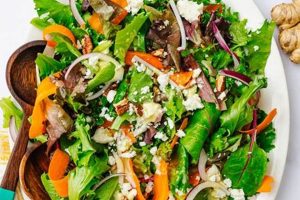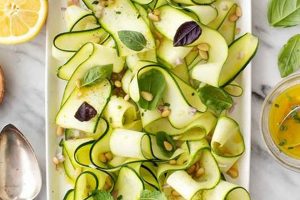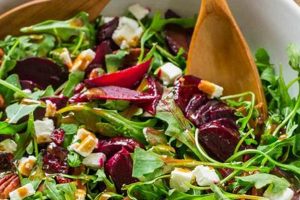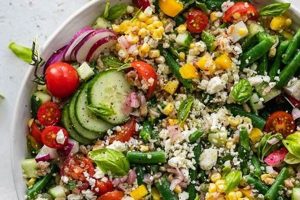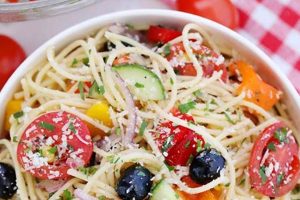Dishes categorized as “fluff salads” typically feature a base of whipped topping folded into various sweet ingredients. A popular brand of whipped topping, frequently incorporated into these recipes, lends its name to a common variation. These salads often include fruits, miniature marshmallows, sometimes nuts, and occasionally other additions like puddings or yogurt. A classic example comprises canned mandarin oranges, crushed pineapple, marshmallows, and the aforementioned whipped topping, creating a light and airy dessert salad.
These desserts offer a convenient and quick preparation, often requiring no cooking and minimal chilling time. Their versatility makes them suitable for potlucks, holidays, or simple weeknight treats. Historically, such recipes gained popularity in mid-20th century America, alongside the rise of convenience foods. Their adaptability to seasonal ingredients and personal preferences contributed to their enduring appeal across generations. This ease of preparation and customizability makes them particularly attractive for novice cooks or those seeking time-efficient desserts.
This exploration will delve further into variations of these chilled desserts, offering insight into ingredient selection, preparation techniques, and potential substitutions for specific dietary needs or preferences. From classic combinations to innovative twists, a range of options will be presented to inspire culinary creativity and satisfy any sweet tooth.
Tips for Creating Excellent Whipped Topping-Based Fruit Salads
Achieving optimal texture and flavor in these desserts relies on a few key considerations. Attention to detail, from ingredient selection to chilling time, ensures a successful outcome.
Tip 1: Thoroughly Drain Canned Fruit: Excess liquid from canned fruits will dilute the whipped topping and create an undesirable watery consistency. Ensure fruits are well-drained before incorporating them into the mixture.
Tip 2: Use Chilled Ingredients: Cold ingredients help maintain the stability of the whipped topping, preventing it from melting or becoming too soft. Chill all components, including the whipped topping itself, before combining.
Tip 3: Fold, Don’t Stir: Gentle folding preserves the airiness of the whipped topping. Avoid vigorous stirring, which can deflate the mixture and result in a denser texture.
Tip 4: Balance Sweetness: Consider the natural sweetness of the chosen fruits when incorporating additional sweeteners. Taste the mixture before serving and adjust accordingly.
Tip 5: Add Nuts and Textures: Toasted nuts, shredded coconut, or miniature pretzels provide contrasting textures and enhance the overall sensory experience.
Tip 6: Chill Before Serving: Allowing the salad to chill for at least 30 minutes allows the flavors to meld and the whipped topping to firm up, resulting in a more enjoyable dessert.
Tip 7: Garnish Appropriately: A simple garnish, such as a sprinkle of chopped nuts or a sprig of mint, elevates the presentation and adds a touch of elegance.
By adhering to these guidelines, one can consistently produce delightful and refreshing fruit salads that are sure to impress.
Following these practical tips ensures a consistently satisfying dessert experience, making these recipes a reliable choice for any occasion.
1. Whipped Topping
Whipped topping serves as the foundational element in “fluff salad recipes,” contributing texture, sweetness, and overall structure. Its properties are crucial to the success of these desserts, influencing both flavor and presentation. Understanding its various facets provides a deeper appreciation for its role in these culinary creations.
- Aeration and Stability:
Whipped topping’s airy texture, achieved through the incorporation of air during processing, provides the characteristic “fluffiness” in these salads. Maintaining this aeration is essential, as it contributes to a light and palatable dessert. Factors such as temperature and handling directly impact stability, making proper chilling and gentle folding techniques critical.
- Sweetness and Flavor Profile:
The inherent sweetness of whipped topping complements the other ingredients, balancing the tartness of fruits or the richness of added components like cream cheese. Its neutral flavor profile provides a versatile backdrop, allowing the flavors of other ingredients to shine without being overpowered. This neutrality also allows for customization through the addition of flavor extracts or spices.
- Binding and Cohesion:
Whipped topping acts as a binding agent, holding the various ingredients together in a cohesive mixture. Its creamy consistency coats the other components, ensuring they remain suspended within the salad rather than settling at the bottom. This binding property contributes to the overall textural experience and prevents the salad from becoming watery or separated.
- Visual Appeal and Presentation:
The bright white color and smooth texture of whipped topping contribute to the visual appeal of the finished dish. Its ability to hold its shape allows for attractive presentation, whether served in a bowl, layered in a trifle dish, or used as a filling for cakes or pastries. This visual element enhances the overall enjoyment of the dessert.
The interplay of these facets contributes to the unique character of desserts featuring whipped topping. From its structural role to its influence on flavor and presentation, whipped topping remains a defining component of these recipes. Selecting the right type and handling it correctly ensures a successful and satisfying culinary outcome.
2. Fruit
Fruit serves as a crucial component in whipped topping-based salads, contributing flavor, texture, and visual appeal. The selection and preparation of fruit significantly influence the overall character of the dish. Understanding the various facets of fruit integration is essential for crafting a successful and enjoyable dessert.
- Flavor Profile and Balance:
The choice of fruit dictates the primary flavor profile of the salad. Tart fruits like berries and citrus provide a refreshing contrast to the sweetness of the whipped topping, while sweeter fruits like bananas and peaches enhance the overall richness. A balanced combination of flavors creates a more complex and satisfying dessert experience. For instance, the tang of mandarin oranges complements the sweetness of pineapple, while the addition of tart cranberries can balance the richness of a banana-based salad.
- Texture and Mouthfeel:
Fruit introduces textural variety to the otherwise smooth and airy whipped topping base. The firmness of apples or grapes contrasts with the softness of berries or bananas. Canned fruits offer a different textural experience compared to fresh, often being softer and more yielding. Consider the interplay of textures when selecting fruits, aiming for a balance that enhances the overall enjoyment of the dish. A combination of grapes and chopped apples provides a pleasant contrast to the soft texture of the whipped topping.
- Visual Appeal and Presentation:
The vibrant colors and diverse shapes of fruits contribute significantly to the visual appeal of the salad. The bright red of strawberries, the deep purple of grapes, or the sunny yellow of pineapple create an attractive presentation. Careful arrangement and garnishing can further enhance the visual appeal, making the dessert more enticing. Consider the color palette when selecting fruits, aiming for a visually appealing combination that complements the white backdrop of the whipped topping. A garnish of fresh mint leaves or a sprinkle of toasted coconut can elevate the presentation.
- Preparation and Preservation:
Proper preparation of fruit is crucial for maintaining texture and preventing unwanted moisture. Fresh fruits should be washed and, if necessary, chopped or sliced into bite-sized pieces. Canned fruits must be thoroughly drained to avoid a watery consistency. Proper storage and chilling help maintain the freshness and quality of the fruit, ensuring a more enjoyable final product. If using fresh berries, gently patting them dry after washing prevents them from releasing excess moisture into the salad. Storing the prepared fruit in an airtight container in the refrigerator helps maintain its freshness until ready to use.
The careful consideration of these facets flavor, texture, visual appeal, and preparation ensures that the fruit component contributes positively to the overall quality and enjoyment of the whipped topping-based salad. A thoughtful combination of fruits elevates the dessert from a simple treat to a more complex and satisfying culinary experience.
3. Sweeteners
Sweeteners play a crucial role in whipped topping-based fruit salads, contributing to flavor balance and overall palatability. While the whipped topping itself offers a degree of sweetness, additional sweeteners are often necessary to achieve the desired flavor profile. The careful selection and application of sweeteners contribute significantly to the success of these desserts. The interplay between the inherent sweetness of the fruit, the sweetness of the whipped topping, and any added sweeteners determines the final taste experience. For instance, tart fruits like raspberries or cranberries may require more additional sweetening than naturally sweet fruits like bananas or peaches.
Common sweeteners used in these recipes include powdered sugar, granulated sugar, marshmallows, and flavored syrups. Powdered sugar dissolves readily into the whipped topping, creating a smooth and consistent sweetness. Granulated sugar offers a slightly coarser texture and may require more mixing to fully incorporate. Miniature marshmallows contribute both sweetness and texture, adding a pleasant chewiness to the salad. Flavored syrups, such as maple syrup or fruit-flavored syrups, can introduce additional flavor dimensions alongside their sweetening effect. The choice of sweetener depends on the desired outcome and the other ingredients in the salad. A fruit salad featuring tart berries might benefit from the addition of a sweet fruit-flavored syrup, while a salad with sweeter fruits might require only a small amount of powdered sugar for balance. Marshmallows provide a textural element in addition to sweetness, making them a popular choice in classic recipes.
Understanding the impact of sweeteners on the overall flavor profile is crucial for achieving a balanced and enjoyable dessert. Over-sweetening can mask the delicate flavors of the fruit, while under-sweetening can result in a bland and unappetizing dish. Careful consideration of the sweetness levels of each ingredient and judicious use of additional sweeteners ensures a harmonious blend of flavors. This balance is particularly important when incorporating ingredients like cream cheese or flavored yogurt, which can add their own sweetness to the mix. Ultimately, the goal is to create a dessert that is both refreshing and satisfying, with a balanced sweetness that complements the other flavors present.
4. Mix-ins
Mix-ins represent a crucial element in whipped topping-based fruit salads, offering opportunities to enhance texture, flavor, and visual appeal. These additions contribute significantly to the overall sensory experience, transforming a simple fruit and whipped topping combination into a more complex and satisfying dessert. Strategic incorporation of mix-ins allows for customization and creativity, catering to individual preferences and dietary needs.
- Textural Contrast:
Mix-ins provide textural contrast to the smooth base of whipped topping and the often-soft texture of the fruit. Nuts, such as chopped pecans, walnuts, or almonds, introduce a satisfying crunch. Toasted coconut flakes offer a delicate crispness. Crushed pretzels or cookies contribute a contrasting crumble. These textural variations elevate the eating experience, adding depth and interest. A salad featuring soft fruits like bananas and berries benefits from the addition of chopped nuts for a textural counterpoint.
- Flavor Enhancement:
Mix-ins can introduce new flavor dimensions, complementing or contrasting with the existing fruit and whipped topping combination. Chocolate chips, butterscotch chips, or peanut butter chips add a touch of sweetness and richness. Miniature marshmallows contribute a classic sweetness and a soft, pillowy texture. Spices, like cinnamon or nutmeg, offer warm and aromatic notes. These flavor enhancements create a more complex and nuanced flavor profile. The addition of chopped candied ginger to a tropical fruit salad adds a spicy and unexpected twist.
- Visual Interest:
Mix-ins contribute visual interest, adding color and variety to the presentation. Colorful candies, sprinkles, or chopped dried fruit create visual pops. The contrast between the colors of the mix-ins and the white backdrop of the whipped topping makes the salad more visually appealing. A sprinkle of chopped pistachios adds a vibrant green hue to a berry-based salad. Colorful sprinkles can enhance the festive appearance of a holiday-themed dessert.
- Nutritional Considerations:
Mix-ins can be used to enhance the nutritional value of the salad. Seeds, such as chia seeds or flax seeds, offer a boost of omega-3 fatty acids and fiber. Dried fruits, like cranberries or raisins, provide antioxidants and other nutrients. Nuts contribute healthy fats and protein. These additions transform the dessert into a more wholesome treat. Incorporating a mix of nuts and seeds adds nutritional value while enhancing the flavor and texture of the salad.
The thoughtful selection and incorporation of mix-ins elevate whipped topping-based fruit salads from simple desserts to more complex and satisfying culinary creations. By considering texture, flavor, visual appeal, and nutritional value, one can create a truly customized and enjoyable dish that caters to a variety of preferences and occasions.
5. Chill Time
Chill time represents a crucial element in whipped topping-based fruit salads, significantly impacting texture, flavor melding, and overall enjoyment. This period of refrigeration affects the structural integrity of the whipped topping and allows the individual flavors of the components to harmonize. The duration of chilling, therefore, directly correlates with the final quality of the dessert.
The primary effect of chilling relates to the stabilization of the whipped topping. A chilled environment maintains the aeration achieved during processing, preventing the topping from deflating and becoming watery. Furthermore, lower temperatures solidify the fat within the topping, contributing to a firmer and more desirable texture. Insufficient chill time can lead to a soft, runny consistency, compromising the structural integrity of the salad. Conversely, excessive chilling can make the salad too firm and difficult to serve. A classic example is a fruit salad incorporating marshmallows. Insufficient chilling may result in the marshmallows absorbing moisture and losing their distinct texture, while adequate chilling maintains their shape and contributes to a more enjoyable eating experience.
Beyond its textural impact, chill time allows the diverse flavors of the fruit, whipped topping, and any added mix-ins to meld and harmonize. The cold temperature slows down the chemical reactions that contribute to flavor degradation, preserving the freshness of the individual components. Simultaneously, it encourages the subtle exchange of flavors between the ingredients, creating a more complex and unified flavor profile. This effect is particularly noticeable in salads containing a variety of fruits with contrasting flavor profiles, such as a combination of tart berries and sweet melon. Adequate chill time allows these disparate flavors to integrate, resulting in a more balanced and harmonious taste.
6. Serving Size
Serving size considerations are essential for whipped topping-based fruit salads, impacting both practical aspects like portion control and overall enjoyment of the dessert. Appropriate portioning ensures that the delicate balance of flavors and textures is preserved, while also preventing waste and contributing to a satisfying culinary experience. Understanding the factors influencing serving size allows for better planning and presentation of these desserts.
- Dish Selection and Presentation:
The choice of serving vessel influences perceived portion size and overall presentation. Individual bowls, ramekins, or small dessert glasses offer controlled portions and an elegant presentation. Larger bowls or platters are suitable for communal sharing but require careful portioning to ensure equitable distribution and maintain the desired balance of ingredients. A trifle dish, with its layered presentation, offers a visually appealing way to control portions while showcasing the various components of the salad.
- Meal Context and Accompaniments:
The role of the salad within the meal context dictates appropriate serving size. As a light dessert following a larger meal, smaller portions are generally sufficient. As a standalone treat or part of a buffet, slightly larger portions may be appropriate. Consideration of accompanying dishes also influences serving size. A rich and decadent dessert alongside the salad might warrant a smaller portion, whereas a lighter accompaniment might allow for a more generous serving.
- Individual Preferences and Dietary Needs:
Individual appetite and dietary restrictions influence appropriate serving sizes. Children or individuals with smaller appetites may require smaller portions than adults. Those following specific dietary guidelines, such as calorie restriction or carbohydrate control, benefit from portion awareness. Offering a variety of serving sizes allows guests to choose portions that align with their individual needs and preferences.
- Recipe Yield and Scalability:
Understanding the yield of a specific recipe helps determine appropriate serving sizes and facilitates efficient planning. Recipes often state the expected number of servings, providing a baseline for portioning. Scalability is also crucial. Adjusting ingredient quantities allows for tailoring the recipe to the desired number of servings, preventing both shortages and excessive leftovers. This adaptability makes these recipes suitable for gatherings of varying sizes, from small family dinners to larger parties.
Appropriate serving size considerations enhance the enjoyment of whipped topping-based fruit salads. From portion control to presentation aesthetics, these factors contribute to a satisfying and balanced culinary experience. By considering dish selection, meal context, individual needs, and recipe yield, one can ensure that these desserts are both delicious and appropriately portioned for any occasion.
Frequently Asked Questions
This section addresses common inquiries regarding whipped topping-based fruit salads, offering clarity on preparation techniques, ingredient selection, and storage practices. These responses aim to provide comprehensive information for achieving optimal results and addressing potential concerns.
Question 1: Can frozen whipped topping be used in these recipes?
While frozen whipped topping can be used, thawed and whipped according to package directions, it may exhibit a slightly different texture compared to refrigerated varieties. Thawing and whipping introduce additional air, potentially resulting in a lighter and less stable consistency.
Question 2: How can one prevent the salad from becoming watery?
Excess moisture from canned fruit is a primary cause of watery salads. Thoroughly draining canned fruit before incorporation is crucial. Additionally, using chilled ingredients and avoiding overmixing helps maintain the whipped topping’s structural integrity.
Question 3: What are suitable alternatives to canned fruit?
Fresh fruit offers a vibrant flavor and textural alternative to canned options. Ensure fresh fruit is ripe but firm, and chop it into bite-sized pieces before adding. Frozen fruit can also be used, but it should be thawed and drained thoroughly before incorporation.
Question 4: How long can these salads be stored?
Refrigeration in an airtight container is recommended. Optimal quality is maintained for 2-3 days, though some separation or textural changes may occur over time. Freezing is not recommended, as it negatively impacts the texture of the whipped topping and fruit.
Question 5: Can these recipes be adapted for specific dietary needs?
Certainly. Sugar-free whipped topping and sweeteners can be used for those following low-sugar diets. Dairy-free whipped topping alternatives cater to lactose intolerance. Ingredient substitutions, such as using maple syrup instead of granulated sugar, offer further customization options.
Question 6: How can one elevate the presentation of these salads?
Garnishes and thoughtful plating enhance visual appeal. Toasted nuts, fresh mint sprigs, or a dusting of cocoa powder elevate presentation. Serving in elegant glassware or layering in a trifle dish adds a touch of sophistication.
Careful consideration of these frequently asked questions ensures optimal results when preparing whipped topping-based fruit salads. Attention to detail, from ingredient selection to storage practices, contributes to a satisfying and enjoyable dessert experience.
The following section explores popular variations of these recipes, offering inspiration for incorporating seasonal ingredients and customizing flavors to suit individual preferences.
Conclusion
This exploration has provided a comprehensive overview of desserts featuring whipped topping and fruit. Key aspects, including ingredient selection, preparation techniques, and serving considerations, have been thoroughly addressed. The versatility of these recipes, adaptable to various fruits, sweeteners, and mix-ins, allows for extensive customization to suit diverse palates and dietary requirements. Proper chilling and handling techniques ensure optimal texture and flavor, while thoughtful presentation elevates the dining experience.
The enduring popularity of these desserts underscores their accessibility and adaptability. Continued experimentation with flavor combinations and presentation styles ensures their relevance in contemporary culinary practices. From classic combinations to innovative variations, these recipes offer a timeless appeal, providing a simple yet satisfying dessert option for generations to come. The ability to incorporate seasonal ingredients and adapt to evolving tastes ensures their enduring presence in culinary traditions.

